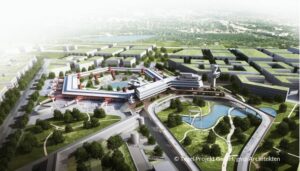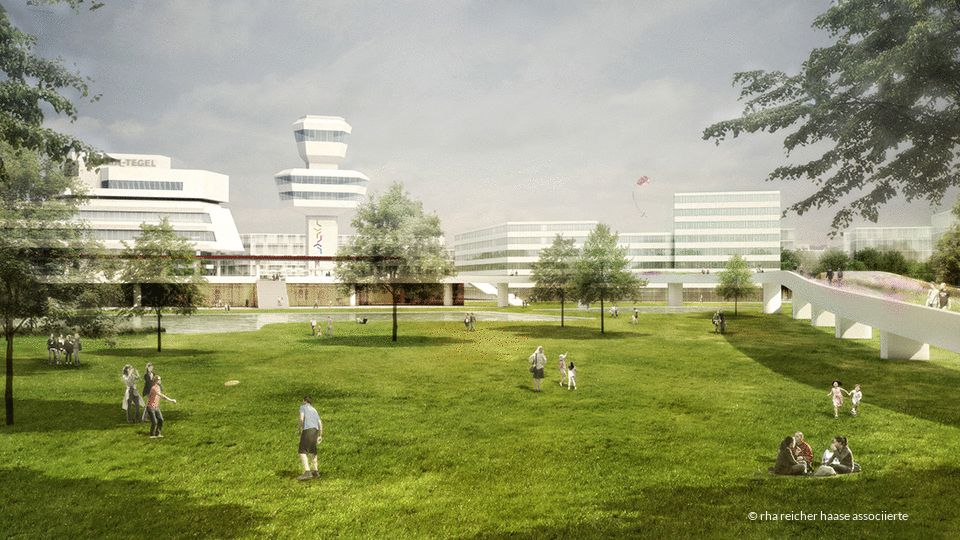More and more people around the world are moving to urban areas. The challenges for cities are immense against the backdrop of climate change, demographic change and digitalisation. Therefore, more than ever, new concepts need to be developed and (urban) construction innovations need to be put into practice. What can it look like in concrete terms, the city of tomorrow? How do we want to live, care for ourselves and get around in urban spaces in the future? What qualities are important to us as individuals and as a community? And what functionalities can we and do we not want to do without? Berlin has set itself the task of providing valid answers to all these questions in the coming years. With the Berlin TXL project, a real laboratory for a CO2-neutral city district and new forms of building will be created from 2021. The technological foundations for this will be researched, tested, produced and cooperatively transferred into marketable solutions directly on site. From the efficient use of energy to sustainable construction, environmentally friendly mobility, recycling and the networked control of systems to clean water and the use of new materials – in a microcosm covering five square kilometres, the city system with all its facets is being rethought and designed for the future.
One of the most ambitious urban development projects in Europe
Six months after the opening of Berlin-Brandenburg International Airport, the inner-city airport Berlin-Tegel will finally close and the dawn of something new can begin. In 2021, the excavators will roll in and the plans for Berlin TXL will become reality – with the Urban Tech Republic, a research and industrial park for urban technologies, and a new, sustainable and social residential area, the Schumacher Quartier. While the Urban Tech Republic offers space for up to 1,000 companies with 20,000 employees, the Schumacher Quartier will provide over 5,000 flats for more than 10,000 people. The concept also envisages a more than 200-hectare landscape area that connects to the local recreational landscape in the west of Berlin. With this reuse of Tegel Airport, one of the largest urban development projects in Europe is coming to fruition. The starting point for the planning already goes back twelve years: as early as 2008, the public discussion about the future of the airport site began, combined with the political mandate to Tegel Projekt GmbH, founded by the state of Berlin in 2012, to develop a location for urban technologies of the future. Six international teams with experts from architecture, urban planning and landscape planning developed proposals that were further developed with other experts, the administration and various interest groups. From the very beginning, interested parties had the opportunity to get involved in the issues at public site conferences – a circumstance that paid off: the fundamental plans were never called into question. Every interest group that had been involved in the participatory process ultimately found itself in it. What emerged is the vision of a better city, because it is clean and social, a city for the people – highly modern and innovative, yet close to nature and respectful in its use of resources. Approaches and methods were developed, such as a car-free urban quarter with multimodal mobility, the consistent implementation of the so-called sponge city principle* or the application of animal-aided design** to increase biodiversity in the built quarter. *The sponge city principle is a way of counteracting the effects of heavy rainfall events by capturing, storing and recycling all precipitation instead of letting it run off superficially. ** Animal-Aided Design is a planning approach that incorporates the needs of urban-dwelling animals into urban, landscape and open space planning. The concept aims to permanently settle wild birds, reptiles or mammals in urban open spaces and to improve the quality of life for people through new forms of experiencing nature in their immediate living environment.
Nature moves into the city
The greening of facades, roofs and open spaces in Berlin TXL is intended to achieve urban-ecological densification. In addition to the visual enhancement, this approach leads to a reduction of air pollution, noise and local heat effects, provides retreat spaces for animals and increases the quality of life for the residents. The introduction of nature into the city reduces energy consumption and makes a positive contribution to the overall ecological system. By applying the sponge city principle, the neighbourhood arms itself against heavy rain, drought and heat. While the water volumes of heavy downpours in cities often cannot seep away, lead to flooding or run off into the sewage system, in the Schumacher Quarter they gradually reach planted zones, flood plains and underground buffer storage via a complex cascade system over blue-green roofs. All rainwater is used or stored in the quarter; nothing is lost. When it evaporates on hot days, it cools the surroundings. When it seeps away, it enriches the groundwater. This self-contained system achieves local climate regulation, which is additionally supported by the many large-leaved deciduous trees that are planted here and act like natural air conditioning systems. A large number of retention and infiltration areas are planned both in the public space and on the buildings. Together with evaporation meadows in the neighbourhood and a selection of plants that are highly pollinator-friendly for insects, these will improve the microclimate in the long term, strengthen biodiversity and offer residents a new, special experience of nature.
Building for humans and animals: Animal-Aided Design
The so-called Animal-Aided Design – developed by ecologist Prof. Dr. Wolfgang Weisser from the Technical University of Munich and landscape architect Dr. Thomas E. Hauck from the University of Kassel – complements the planning: in this way, the new district will also become a quarter for animals and an important experimental area for the still young planning method. Open spaces and buildings in the Schumacher Quarter will be designed to meet the needs of 14 selected rare animal species, including squirrels, broad-winged bats, kestrels or nightingale grasshoppers. Species-appropriate living conditions are being created for them in the residential quarter and the adjacent landscape park – with the aim of systematically settling them permanently and also attracting other species with them, so that ultimately the finished residential quarter will have a higher level of biodiversity than the current open space.
Clean mobility
Environmental friendliness and resource conservation are also at the core of Berlin TXL’s concept of mobility. While new mobility concepts are being researched in the Urban Tech Republic innovation park, the Schumacher Quartier is the direct test field. This is planned to be largely car-free: Only taxis, delivery vehicles and ambulances will be able to drive into the residential area. Except for people with disabilities, there will be no parking spaces in the streets. Vehicles can park in the neighbourhood garages at the edges of the neighbourhood. The most important transfer points between the different modes of transport in Berlin TXL are called Mobility Hubs. They make it attractive to switch from motorised private transport to bicycles and public transport and link innovative technologies such as autonomous systems with components such as bikesharing, carsharing and e-mobility. Six-metre-wide cycle paths cross the entire area and are connected to the existing cycle paths in the neighbouring districts.
Marketplace for heat and cold
The energy supply for the area is provided by a new low-temperature network. This so-called LowEx network is operated at temperatures of up to 40 degrees Celsius. Due to the lower operating temperature compared to a classic district heating network, heat losses can be reduced. In addition, heat pumps installed at the consumers generate higher temperatures as well as cooling energy when needed. The LowEx network can absorb surplus or self-generated energy (e.g. production waste heat from the site’s commercial and industrial operations or energy from renewable sources), thus turning customers into producers at the same time. Because everything is generated, stored and consumed directly on site in a decentralised and sustainable manner from a mix of combined heat and power plants, solar plants, geothermal energy and wastewater heat, the network functions as an energy exchange point.
Digitalisation and intelligent networking
To achieve all these ambitious goals, the use of digital technologies is necessary. This is because digitalisation helps to better tap efficiency and sustainability potentials: be it resource-saving water management, intelligent utilisation of power grids or energy savings through networked sensor technology. The establishment of new production chains and the entire construction sector are also being shaped by technological innovations and digitalisation. In Berlin TXL, a sustainable, digital infrastructure – a digital machine room, so to speak – is being established for this purpose. Intelligent networking in conjunction with innovations in the construction sector makes it possible to reconcile environmental friendliness and quality of life and to transfer (urban) construction experiments into practice. By thinking about and implementing these topics together, a double opportunity is created: to develop answers to the major global challenges and at the same time to establish new business fields.
Timber construction – on an industrial scale
Another building block on the way to a climate-neutral (or even climate-positive) city is the use of sustainable, regenerative building materials. Wood in particular enables long-term CO2 storage, and the use of wood as a building material reduces the consumption of environmentally harmful materials such as concrete. In conjunction with the wood-rich surrounding area of Brandenburg, Berlin TXL has the opportunity to innovatively combine fundamental challenges of the construction industry such as climate protection and resource consumption with global trends such as digitalisation and current urban development policy issues. The aim is to establish a new value chain that includes players from local forestry, production, logistics, assembly, housing construction and urban infrastructure. Together with Bauhütte 4.0 – a forum for investigating new strategies for the use of wood in Berlin’s construction industry – an innovation cluster and production centre for buildings made of wood can be created, where components for the adjacent Schumacher Quarter – and beyond – are developed and manufactured.
A microcosm that should set a precedent
Climate change, demographic change, digitalisation, urbanisation: the changes in the framework conditions are multifaceted and bring existential challenges. If we want to shape a future worth living in, we have to start in the cities. And when we build something new, we do not build against nature, but with it. Berlin TXL is designed to be a showcase, an experimental workshop for the human- and nature-friendly city of the future and for the interaction of the most diverse concepts in a concrete implementation. A small smart city in the metropolis, with the mission to radiate outwards. Because in perspective, the path can only lead to a sustainable and networked future. It is therefore a great responsibility to show what is possible here – and to create something worthy of imitation.

Published in IMMOZEIT, issue “Aufbruch”.
